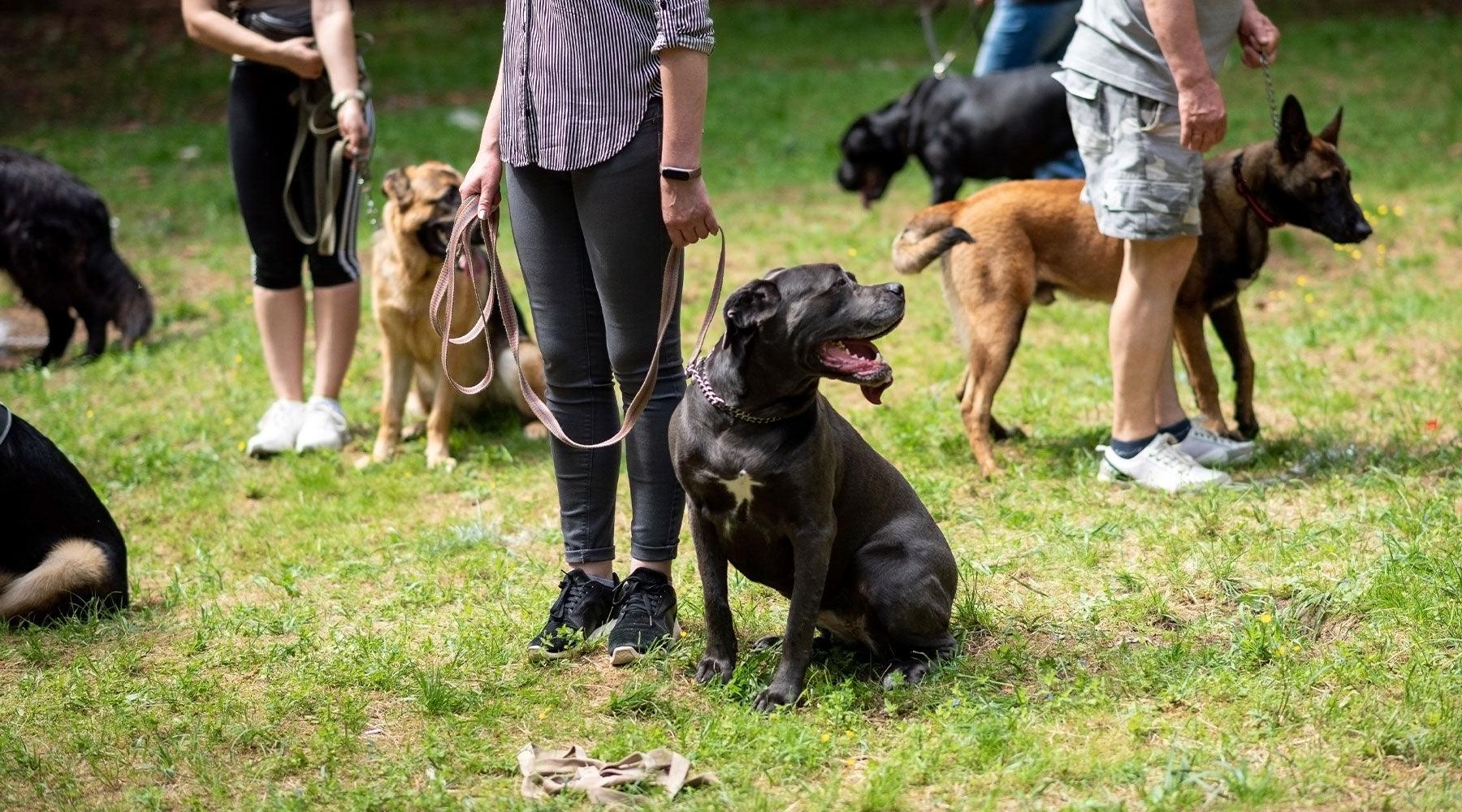Dogs can be astoundingly like people in certain regards. Learning is one of the aspects where we and our pups have a lot in common. One person will learn differently than the other, and very much the same goes for dogs.
This is precisely why numerous training methods have been devised over time. Some have developed naturally as an extension of the intuitive relationship between people and dogs. Other techniques were constructed by experts with particular learning goals in mind.

If you want to train your dog properly, you should find the training method that works for them – and for you. Every technique will have advantages and downsides, and weighing the pros and cons may be a matter of trial and error. Luckily, we can help you narrow down the options a bit.
Let’s look at the most prominent dog training techniques and explain their major pros and cons.
Science-Based Training
A science-based training technique depends on research, empirical evidence, and a deep understanding of how precisely dogs learn. The particular scientific branches that form the foundation of this method include animal behaviour (ethology), dog cognition, and conditioning.
Although it might sound like the most clear-cut training technique, the science-based approach isn’t precisely defined. However, this is not due to a lack of clarity. Instead, the issue is that research and new observations keep changing the method in an attempt to perfect it.
The essence of this training method is in following the latest practices. You could even view it as an attitude toward training instead of a full-blown technique. After all, other methods utilise empirical proof and research to some extent, although they don’t fall under the umbrella of science-based training.
The greatest benefit of this method is that it deepens your knowledge of dog behaviour. On the other hand, the downside could be the exceptional time commitment required to study the latest data constantly. This is also the primary reason why science-based training is mainly reserved for professionals.
Model-Rival Training
If the previous method may seem somewhat artificial, the model-rival technique is pretty much as natural as training approaches go. However, this method is also among the least utilised. The reason is that the model-rival technique might be less efficient for daily tasks, which is why many see it as a form of specialised training.
The core philosophy behind this method is straightforward: The dog learns by observing the behaviour of another dog or a human. Since dogs are instinctively social, they’ll quickly pick up on desirable behavioural patterns.
While practising this approach, the trainee dog will observe the other, assistant dog as they fetch or perform another action on command. The assistant dog should always be rewarded for the action so that the trainee starts to grasp the benefits of responding to commands.
The method gets its name from the way the trainee dog perceives the other pup. On the one hand, they see the other dog as a model, which is understandable in itself. On the other hand, the assistant dog also represents a rival, since they get to enjoy all of the attention and treats.
The main advantage of this technique is its use in teaching dogs to perform specific tasks or jobs. The disadvantage, as mentioned, is that the model-rival method isn’t universal and will be hard to apply to everyday skills.
Positive Reinforcement
Positive reinforcement is undoubtedly one of the most popular training techniques. It relies exclusively on supporting positive behaviour with rewards. The “positive” in the name means adding a stimulus or treat to make the dog reapply or “reinforce” the behaviour they showed.
While most dogs react favourably to positive reinforcement, they’ll differ based on their preferred reward. Some pups will be overjoyed to get nothing more than praise or some patting. Others will settle for some playtime like fetch or tug-of-war. But dogs that drive a particularly hard bargain will only accept actual treats.
This approach requires plenty of repetition and the patience that comes with the considerable time investment. However, positive reinforcement is very worth your while. It provides excellent results, builds a strong bond between the dog and their owner, and, maybe most importantly, makes the pup enjoy every session.

Obviously, positive reinforcement is very much about the pros, which is why this technique is so popular. The only considerable cons are the amount of attention and patience required, although every loving dog owner should have plenty of those resources.
Specialised Training
Specialised training is intended for a particular purpose. With this approach, the main question isn’t how to help your pup learn a certain behavioural pattern. Instead, it’s about which skills you want to teach them.
Some of the most common forms of specialised training include obedience, behaviour, therapy, protection, agility, and service. These forms don’t necessarily rely on exact methods of training. Rather, they represent the goals you and your pup are trying to reach.
Obedience is geared toward learning commands, while behaviour often means retraining the dog to overcome anxiety, aggression, or other behavioural issues. Therapy, protection, and service are very job-orientated, and agility training involves activities like obstacle courses.

The greatest positive about specialised training is that it can cover certain areas that regular training can’t address sufficiently. The downside is that this training type isn’t a unified method but more of an approach to training with a defined outcome in mind.
Relationship-Based Training
While some training types may provide faster results, none will be as warm and carefree as relationship-based training. This technique takes the process step by step, easing the pup into every following phase.
For instance, you could start teaching your pup a basic command in an area free of distractions. Then, once the dog starts responding to the command regularly, you may progress to training in a more open but controlled environment. The next step would include getting your pup in a public space, like a park, and training the same command with them there.
The point of this method is to help your dog learn various commands while never letting them feel stressed. However, this also means that you as the owner will need to show extra commitment. In particular, you’ll need to develop a profound understanding of certain aspects of your dog’s behaviour.
For instance, you should pay special attention to any reason why the pup might be struggling with the training. Dogs can react poorly to training routines due to fatigue, injury, or simply because something in their learning environment doesn’t sit right with them.

As a different example of the commitment this approach requires, you’ll need to learn to recognise what the dog is feeling at any given moment. If they give off signals of nervousness or stress, you should adapt your approach to calm them down. Surprisingly, this isn’t as hard to do as it seems – just like humans, dogs have body language that will communicate quite clearly if something is off.
A significant positive about relationship-based training is that it can function as a method of its own or serve as a basis for other training approaches. The trust you establish with the pup will go a long way, regardless of the concrete techniques you employ.
The con of this method is that it may take extra time to provide results. This is particularly true when it comes to strong-willed dogs.
Clicker Training
While clicker training may be viewed as a subcategory of positive reinforcement, there’s plenty about this technique to recommend it as a distinct approach to dog training. If you’re not familiar with the term, clickers are small mechanical gadgets that produce a clicking sound when pressed. This sound functions as a neutral stimulus in what psychology calls classical conditioning (think Pavlov dogs).
In essence, you train the dog with a clicker by associating the sound with a particular reward. This is called “charging the clicker,” and it represents the first step in this method. You’ll offer the pup a treat right after making the sound. This initial phase only serves to create a connection between the two.
After your dog has developed a reflex based on the clicking sound, you can move on to issue a command before clicking and giving them a treat. Sometimes you’ll need to cheat a bit here, especially in the beginning: Wait for the pup to perform the desired action on their own or nudge them in the right direction a bit.
The rest of the process will consist of repetition. Of course, this means progressing gradually, with plenty of patience and a pouch full of treats. The positive side of clicker training is the possibility of teaching your dog very complex tasks. It’s a precise method that quickly makes it clear which behaviour is desired.
On the negative side, clicker training will require good coordination on your part. Many dog owners opt for a clicker that’s easier to press so they can get the timing right without effort. This training type also doesn’t lend itself to getting rid of negative behaviour patterns – it’s mostly useful for teaching the pup what to do, but not what not to do.
Get Your Dog the Training They Deserve
Dog owners can rest assured there are plenty of training methods to help them achieve a particular goal. The only trick when choosing a technique is to figure out what will work best for your pup. Now that you’ve learned what makes some of the most popular approaches unique and understood their major pros and cons, deciding on the best technique for your four-legged friend will be much easier.

